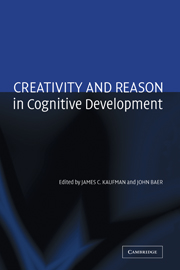Book contents
- Frontmatter
- Contents
- List of Contributors
- Acknowledgments
- Creativity and Reason in Cognitive Development
- Introduction
- COGNITIVE PERSPECTIVES
- 1 Expertise and Reason in Creative Thinking: Evidence from Case Studies and the Laboratory
- 2 Creative Genius, Knowledge, and Reason: The Lives and Works of Eminent Creators
- 3 Dynamic Processes Within Associative Memory Stores: Piecing Together the Neural Basis of Creative Cognition
- 4 The Creativity of Everyday Moral Reasoning: Empathy, Disgust, and Moral Persuasion
- 5 Reasoning and Personal Creativity
- 6 Alternative Knowledge Structures in Creative Thought: Schema, Associations, and Cases
- 7 The Role of the Knowledge Base in Creative Thinking
- 8 The Role of Domain Knowledge in Creative Problem Solving
- 9 Creative Thinking and Reasoning: Can You Have One Without the Other?
- 10 From Alexithymia, Borne of Trauma and Oppression, to Symbolic Elaboration, the Creative Expression of Emotions, and Rationality
- 11 Opening up Creativity: The Lenses of Axis and Focus
- DEVELOPMENTAL AND EDUCATIONAL PERSPECTIVES
- Author Index
- Subject Index
- References
7 - The Role of the Knowledge Base in Creative Thinking
Published online by Cambridge University Press: 19 January 2010
- Frontmatter
- Contents
- List of Contributors
- Acknowledgments
- Creativity and Reason in Cognitive Development
- Introduction
- COGNITIVE PERSPECTIVES
- 1 Expertise and Reason in Creative Thinking: Evidence from Case Studies and the Laboratory
- 2 Creative Genius, Knowledge, and Reason: The Lives and Works of Eminent Creators
- 3 Dynamic Processes Within Associative Memory Stores: Piecing Together the Neural Basis of Creative Cognition
- 4 The Creativity of Everyday Moral Reasoning: Empathy, Disgust, and Moral Persuasion
- 5 Reasoning and Personal Creativity
- 6 Alternative Knowledge Structures in Creative Thought: Schema, Associations, and Cases
- 7 The Role of the Knowledge Base in Creative Thinking
- 8 The Role of Domain Knowledge in Creative Problem Solving
- 9 Creative Thinking and Reasoning: Can You Have One Without the Other?
- 10 From Alexithymia, Borne of Trauma and Oppression, to Symbolic Elaboration, the Creative Expression of Emotions, and Rationality
- 11 Opening up Creativity: The Lenses of Axis and Focus
- DEVELOPMENTAL AND EDUCATIONAL PERSPECTIVES
- Author Index
- Subject Index
- References
Summary
Creativity is adaptive behavior. At a low and simple level it is exhibited by 2-year-old Mary, who, deprived of her pacifier, sees her thumb as an acceptable substitute. Later it is 6-year-old Christopher who wants to play Santa Claus on Christmas Eve but does not have access to a commercial Santa Claus outfit. However, he sees how to adapt some cotton for a beard, some shiny black paper for boots, and some red cloth he has seen in a closet for a coat. What emerges, with a bit of help from his mother, is a credible creation of Santa and of a Santa Claus suit. It is a problem or need that causes Mary and Christopher to seek and create a solution as opposed to simply crying or doing nothing. Later there is a teenager who plans a costume party for his friends or the graduating senior who has designed an attractive vita to enhance her summer job search. Wherever there is need to make, create, imagine, produce, or design anew what did not exist before – to innovate – there is adaptive or creative behavior, sometimes called “small c.” On the other end there is “big C” in the invention of a new automobile that runs on both gasoline or electricity, the composition of a new symphony, the discovery of a new drug that reduces the dementia of Alzheimer's disease, or the production of a new work of art.
Information
- Type
- Chapter
- Information
- Creativity and Reason in Cognitive Development , pp. 137 - 144Publisher: Cambridge University PressPrint publication year: 2006
References
Accessibility standard: Unknown
Why this information is here
This section outlines the accessibility features of this content - including support for screen readers, full keyboard navigation and high-contrast display options. This may not be relevant for you.Accessibility Information
- 10
- Cited by
